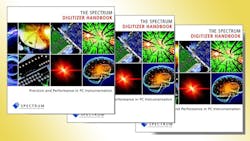Digitizers are versatile test instruments that serve as valuable companions, and at times replacements for, digital oscilloscopes on a test bench. But selecting and using a digitizer for different high-frequency applications requires a good understanding of these devices. Fortunately, test-instrument developer and supplier Spectrum has published a 120-page handbook that serves as an excellent introduction to digitizers, explaining how to specify a digitizer and when the instrument can replace an oscilloscope. The digitizer handbook is available free of charge via the firm’s website.
The full-color printed handbook covers the major digitizer product features, explaining the different terms used for digitizers and how these instruments compare to other test instruments, including digital oscilloscopes and spectrum analyzers. The handbook offers numerous examples to help optimize performance, including accuracy and measurement speed. It details the effects of signal conditioning and how digitizers can be used with different probes and sensors for the best measurement results.
It also reviews software and how different code works with measurement speed and accuracy, and the ways different programming languages, such as Visual C++, Borland C++, Gnu C++, and Visual Basic, can be used to create device drivers for digitizers. The handbook reviews how debugging tools can be employed to test different test hardware and check data transfer speeds. The handbook even contains a section for users who would prefer to operate their digitizers without any programming.
The handbook provides a section on signal processing, and highlights such functions as signal averaging and frequency-domain analysis. It’s a useful reference for anybody considering the use of a digitizer for a wide range of test-and-measurement applications.
Spectrum Systementwicklung Microelectronic GmbH, Ahrensfelder Weg 13-17, 22927, Grosshansdorf, Germany; +49 (0) 4102 6956-0, FAX: +49 (0)4102 6956-66, E-mail: [email protected]

